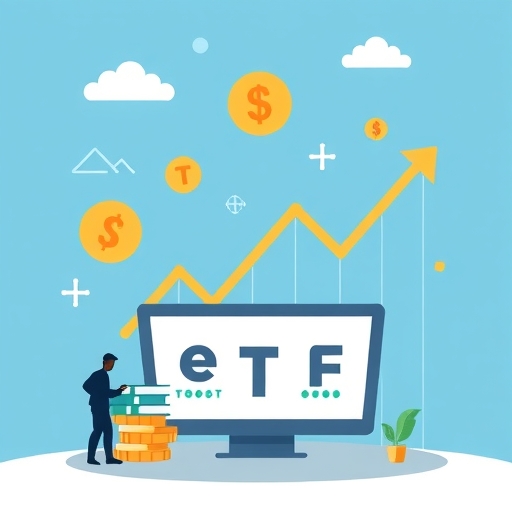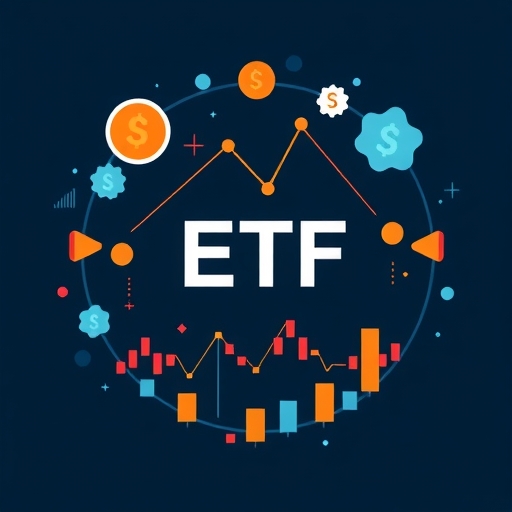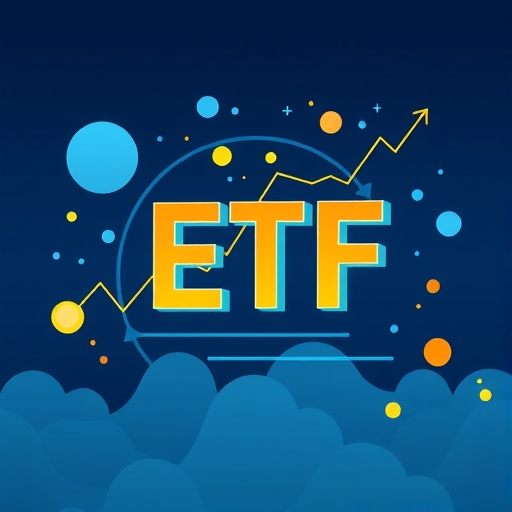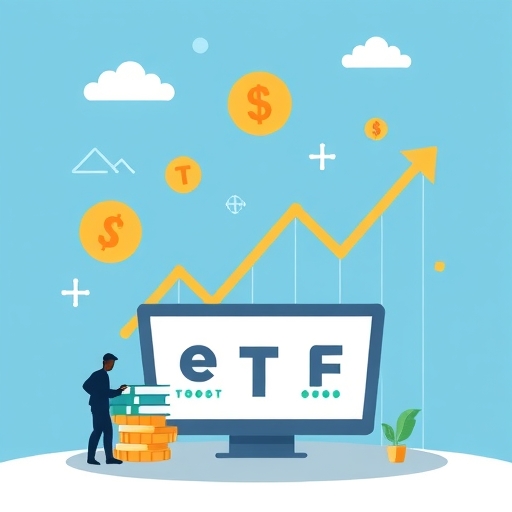Exchange-Traded Funds (ETFs): Your Comprehensive Guide to Modern Investing
Have you ever wondered how to invest in a diverse basket of companies or assets without buying each one individually, all while keeping costs low and maintaining flexibility? This is where Exchange-Traded Funds (ETFs) come into play, revolutionizing how many of us approach investing.  ETFs offer a compelling blend of diversification, transparency, and cost-efficiency, making them a cornerstone for modern portfolios. In this comprehensive guide, we’ll demystify ETFs, exploring their fundamental nature, key advantages, diverse categories, and essential considerations for making informed investment decisions. Whether you’re just starting your investment journey or looking to refine your existing portfolio, understanding ETFs is crucial for building a resilient and potentially high-performing future.
ETFs offer a compelling blend of diversification, transparency, and cost-efficiency, making them a cornerstone for modern portfolios. In this comprehensive guide, we’ll demystify ETFs, exploring their fundamental nature, key advantages, diverse categories, and essential considerations for making informed investment decisions. Whether you’re just starting your investment journey or looking to refine your existing portfolio, understanding ETFs is crucial for building a resilient and potentially high-performing future.
What Exactly is an ETF and How Does It Work?
At its core, an Exchange-Traded Fund (ETF) is a type of investment fund that holds a collection of underlying assets, such as stocks, bonds, commodities, or even cryptocurrencies. Think of it like a basket filled with different items. When you buy a share of an ETF, you’re buying a piece of that basket, not directly owning the individual items inside.  This is similar to how a mutual fund works, where investors pool their money to buy a diversified portfolio. However, the key difference – and what makes ETFs so powerful – lies in how they are traded.
This is similar to how a mutual fund works, where investors pool their money to buy a diversified portfolio. However, the key difference – and what makes ETFs so powerful – lies in how they are traded.
Unlike traditional mutual funds, which are typically priced once a day after the market closes based on their Net Asset Value (NAV), ETFs are traded on stock exchanges throughout the day, just like individual stocks. This means their prices fluctuate constantly based on supply and demand, allowing you to buy or sell shares at any point during market hours.  You’ll see a bid price (the highest price a buyer is willing to pay) and an ask price (the lowest price a seller is willing to accept), similar to stock trading. This intraday trading flexibility is a major advantage for investors who want more control over their buy and sell points.
You’ll see a bid price (the highest price a buyer is willing to pay) and an ask price (the lowest price a seller is willing to accept), similar to stock trading. This intraday trading flexibility is a major advantage for investors who want more control over their buy and sell points.
So, how are these baskets of securities created and redeemed to ensure their market price stays close to their actual value (NAV)? This unique process involves what are known as Designated Brokers and Market Makers. In the primary market, a fund company works with a Designated Broker (often a large bank or securities dealer). The broker delivers a specific basket of underlying securities to the fund company in exchange for new ETF units. These new units are then sold to investors in the secondary market (the stock exchange).  If there’s high demand for an ETF, more units can be created. Conversely, if demand is low, units can be redeemed by the Designated Broker, returning the underlying securities to them. Market Makers continuously buy and sell ETF units on exchanges, ensuring that the ETF’s trading price remains aligned with its NAV and that there’s always a reasonable bid-ask spread. This mechanism helps prevent the ETF from trading at a significant premium or discount to the value of its holdings, providing stability and fair pricing for investors. Sometimes, small discrepancies can arise, especially if the ETF holds international securities that trade on different time zones or if the underlying assets are illiquid.
If there’s high demand for an ETF, more units can be created. Conversely, if demand is low, units can be redeemed by the Designated Broker, returning the underlying securities to them. Market Makers continuously buy and sell ETF units on exchanges, ensuring that the ETF’s trading price remains aligned with its NAV and that there’s always a reasonable bid-ask spread. This mechanism helps prevent the ETF from trading at a significant premium or discount to the value of its holdings, providing stability and fair pricing for investors. Sometimes, small discrepancies can arise, especially if the ETF holds international securities that trade on different time zones or if the underlying assets are illiquid.
The Compelling Advantages of ETF Investing
ETFs have gained immense popularity for a reason: they offer a range of compelling benefits that can significantly enhance your investment strategy. Let’s explore some of the most prominent advantages that make them attractive to a wide spectrum of investors.
ETFs are versatile tools that can cater to a wide array of investment objectives. Their structure allows for various strategic applications, whether you are aiming for long-term growth, income generation, or specific market exposure. Understanding how ETFs align with different financial goals can help you make more informed decisions about incorporating them into your portfolio.
- For investors seeking broad market exposure with low costs, passively managed index ETFs are an excellent choice, mirroring the performance of major indices like the S&P 500.
- Those focused on generating regular income can look into bond ETFs or dividend-focused equity ETFs, which distribute interest or dividend payments from their underlying holdings.
- If you have a conviction about the future performance of a specific industry, sector ETFs allow for targeted investment without the need to pick individual stocks within that sector.
Firstly, diversification is perhaps the most celebrated benefit. When you invest in an ETF, you’re not putting all your eggs in one basket. Instead, you’re instantly diversified across numerous securities, industries, or even entire regions. For instance, an ETF tracking the S&P 500 allows you to invest in 500 of the largest U.S. companies with a single purchase, spreading your risk far more effectively than buying just one company’s stock. This instant diversification helps to stabilize portfolio performance and significantly minimizes the risk associated with any single asset performing poorly.
Secondly, ETFs offer remarkable transparency. Most ETF providers publish their holdings daily, meaning you know exactly what companies or assets are in your fund at any given time. This level of disclosure helps you avoid duplicate investments across your portfolio and ensures you’re comfortable with what you own. In contrast, many traditional mutual funds only disclose their holdings quarterly or semi-annually, leaving you less informed.
Thirdly, the trading flexibility of ETFs is a game-changer. As we discussed, they trade like stocks on major exchanges such as the New York Stock Exchange (NYSE) or the Toronto Stock Exchange (TSX). This means you can buy or sell them throughout the trading day, giving you precise control over your entry and exit points. You can also use various order types, like limit orders, to specify the exact price you’re willing to pay or receive, which isn’t possible with mutual funds.
Fourthly, lower costs are a significant draw. ETFs generally feature much lower management fees and operating costs compared to traditional mutual funds. These combined costs are expressed as the Management Expense Ratio (MER). A lower MER means more of your investment returns stay in your pocket, which can lead to substantial compounding growth over the long term. For example, if two funds generate identical gross returns, the one with a lower MER will always provide a higher net return to you, the investor.
Lastly, ETFs are often celebrated for their tax efficiency, particularly passively managed index ETFs. Due to their unique creation and redemption process and typically low security turnover (meaning they don’t frequently buy and sell underlying assets), ETFs often result in fewer taxable events, such as capital gains distributions, for investors. When you sell an ETF, any capital gain or loss is realized by you, the investor, rather than being distributed from within the fund to all shareholders, as can happen with actively managed mutual funds. This can translate into more money remaining invested and growing tax-deferred, especially if held in tax-advantaged accounts like a Tax-Free Savings Account (TFSA) or a Registered Retirement Savings Plan (RRSP) in Canada, or similar accounts in other regions.
To further highlight the benefits, here is a summary of the compelling advantages that make ETFs a popular choice for many investors:
| Advantage | Description | Benefit to Investor |
|---|---|---|
| Diversification | Instant exposure to a basket of securities across various assets or sectors. | Reduces specific asset risk and provides smoother portfolio performance. |
| Transparency | Holdings are typically disclosed daily by ETF providers. | You always know what you own, aiding in portfolio management and avoiding overlaps. |
| Trading Flexibility | Can be bought and sold throughout the trading day like stocks. | Offers precise control over entry and exit points, allowing for limit orders. |
| Lower Costs | Generally have lower management fees (MER) than traditional mutual funds. | More of your investment returns stay with you, enhancing long-term compounding. |
| Tax Efficiency | Unique structure often leads to fewer taxable capital gains distributions. | Potentially higher after-tax returns, especially in non-registered accounts. |
Exploring the Diverse Landscape of ETF Types and Strategies
The world of ETFs is incredibly diverse, offering a fund for almost every investment goal or strategy. Understanding the different types can help you pinpoint the right fit for your portfolio. Let’s take a look at some of the most common and specialized categories:
- Broad-Market Index ETFs: These are among the most popular. They aim to track a wide market index, such as the S&P/TSX Composite Index in Canada or the S&P 500 in the U.S. They offer instant, extensive diversification and are often used for core asset allocation in a long-term investment strategy. For example, a broad-market ETF might provide exposure to thousands of companies across various sectors.
- Quantitative ETFs (Factor Investing): These funds focus on specific characteristics or “factors” of securities that academic research suggests may lead to higher returns or lower volatility over time. Examples include factors like “value” (investing in undervalued companies), “momentum” (companies with recent strong performance), or “low-volatility” (companies with historically stable stock prices). These are often referred to as Smart Beta ETFs because they use alternative indexing strategies beyond traditional market capitalization weighting.
- Active Fundamental ETFs: While many ETFs are passively managed (meaning they simply track an index), Active Fundamental ETFs are managed by portfolio managers who conduct research and actively select securities. Their goal is to outperform a benchmark index or achieve specific outcomes by capitalizing on market inefficiencies, especially in complex asset classes like preferred shares or certain fixed income markets.
- Sector ETFs: These funds invest in companies within a specific industry or economic sector, such as technology, energy, finance, or healthcare. If you believe a particular sector is poised for growth, a Sector ETF can provide targeted exposure.
- Commodity ETFs: These funds track the price of raw goods like gold, oil, natural gas, or agricultural products. They often do so through derivatives contracts or, in some cases, by holding the physical commodity.
- Bond ETFs (Fixed-Income ETFs): These invest in various types of bonds, including corporate bonds, government bonds, or municipal bonds, aiming to generate regular income payments. They can be a key component for portfolio diversification and risk reduction, especially in a balanced investment strategy.
- International ETFs: Want exposure to markets beyond your home country? International ETFs provide access to foreign stocks and markets, helping to further diversify your portfolio geographically.
- Bitcoin/Crypto ETFs: A more recent development, these ETFs directly track the price of cryptocurrencies like Bitcoin or offer exposure to the crypto market through futures contracts or companies involved in the blockchain industry. The introduction of Bitcoin ETFs has significantly impacted the demand and price dynamics of the underlying cryptocurrency.
- Leveraged ETFs: These funds use debt and financial derivatives to amplify the returns of an underlying index, often aiming for 2x or 3x the daily performance. While they offer the potential for magnified gains, they also come with significantly increased risk and are generally not suitable for long-term holding due to their daily rebalancing.
- Inverse ETFs: Designed to profit from a decline in an underlying index, Inverse ETFs use bullish derivatives to achieve their goal. Like Leveraged ETFs, they are typically used for short-term speculation or hedging and carry high risk.
- Currency ETFs: These funds track the performance of specific currencies or baskets of currencies, allowing investors to speculate on foreign exchange movements or hedge against currency risk.
- Exchange-Traded Notes (ETNs): While often confused with ETFs due to similar trading characteristics, ETNs are actually unsecured debt instruments issued by a financial institution. They promise to pay returns linked to an underlying index, but carry credit risk of the issuer, which ETFs typically do not.
- Asset Allocation ETFs: These funds are designed to behave like an entire portfolio in a single package. They often contain a mix of other ETFs (e.g., stock ETFs and bond ETFs) and are managed according to a specific asset allocation strategy, such as a “balanced” or “growth” portfolio. They simplify portfolio management for investors.
- Alternative ETFs: These offer exposure to alternative asset classes that traditionally have been difficult for individual investors to access, such as hedge funds or managed futures strategies.
Navigating the Risks, Costs, and Practicalities of ETF Ownership
While ETFs offer numerous benefits, it’s crucial to understand their potential drawbacks and practical considerations before investing. No investment is without risk, and ETFs are no exception.
One primary disadvantage is market sensitivity. The value of an ETF is directly linked to the performance of its underlying assets. This means that if the broader market experiences a downturn, or if the specific sector or asset class an ETF invests in struggles, the ETF’s value will likely decline. You are still exposed to market, economic, and company-specific changes, just as you would be with individual stocks or mutual funds.
Another important factor is tracking error. While most ETFs aim to perfectly mirror the performance of their benchmark index, their actual performance may deviate slightly. This discrepancy, known as tracking error, can be caused by the ETF’s management fees, transaction costs incurred by the fund, the liquidity of the underlying assets, or the fund’s sampling methodology (where it holds a representative sample of assets rather than all of them). For example, an ETF tracking the Dow Jones Industrial Average Index might perform 0.1% differently than the actual index due to these factors.
When investing in ETFs, you’ll also encounter trading costs. While the MER for ETFs is generally low, you typically pay brokerage commissions each time you buy or sell ETF units. If you trade frequently or invest small amounts regularly, these commissions can add up and eat into your returns. Some brokers, like Questrade, offer commission-free ETF purchases, which can be a significant advantage, but sales still incur fees. This is a key difference from mutual funds, which often have sales charges or trailer fees but typically don’t have per-transaction trading fees.
Furthermore, while ETFs offer diversification, some can still lead to incomplete diversification or over-concentration risk. For instance, a highly specialized Sector ETF, like one focused solely on renewable energy, might provide diversification within that niche but still expose you to significant risk if the entire sector faces headwinds. It’s essential to look at the ETF’s actual holdings and understand its concentration levels.
Liquidity issues can arise with less frequently traded ETFs. While major ETFs are highly liquid, some niche or smaller funds might have wider bid-ask spreads, making it harder to buy or sell at your desired price. This is particularly relevant for investors dealing with large sums or those needing to exit a position quickly. Finally, there’s always a slight fund closure risk. If an ETF fails to attract sufficient assets or becomes unprofitable for the issuer, it may be closed down, forcing investors to sell their units, potentially at a loss, and incurring transaction costs.
While the advantages are significant, it’s equally important for investors to be aware of the potential risks and practical considerations associated with ETF ownership. Understanding these factors can help in mitigating unexpected challenges and making more robust investment decisions.
| Risk/Consideration | Explanation | Mitigation Strategy |
|---|---|---|
| Market Sensitivity | ETF value is directly tied to the performance of underlying assets and broader market conditions. | Diversify across different asset classes and geographies; maintain a long-term perspective. |
| Tracking Error | The ETF’s performance may slightly deviate from its benchmark index due to fees, costs, or sampling. | Choose ETFs with low MERs and a history of tight tracking; review the fund’s methodology. |
| Trading Costs | Brokerage commissions apply to buying and selling ETF units, which can add up with frequent trading. | Utilize commission-free ETF platforms for purchases; minimize frequent trading; consider dollar-cost averaging. |
| Incomplete Diversification | Highly specialized ETFs (e.g., sector-specific) may still carry concentration risk. | Examine the ETF’s holdings; combine specialized ETFs with broad-market funds for overall portfolio balance. |
| Liquidity Issues | Less frequently traded ETFs might have wider bid-ask spreads, affecting trade execution price. | Stick to highly liquid, large-cap ETFs for core holdings; use limit orders for less liquid funds. |
ETF Comparison Table: What Fits Your Investment Style?
To help you decide, let’s compare ETFs with other common investment vehicles:
| Feature | Exchange-Traded Fund (ETF) | Mutual Fund | Individual Stock |
|---|---|---|---|
| Diversification | High (basket of securities) | High (basket of securities) | Low (single company) |
| Trading Flexibility | Traded intraday on exchange (like stocks) | Priced once daily (end-of-day NAV) | Traded intraday on exchange |
| Costs (MER) | Generally lower | Generally higher | N/A (no MER, but research costs) |
| Transparency | Daily holdings disclosure | Quarterly/semi-annual holdings disclosure | Full company financials available |
| Brokerage Commissions | Typically per trade (buy/sell) | Often no direct trade commission (may have sales charges/trailer fees) | Typically per trade (buy/sell) |
| Tax Efficiency | Often higher (low turnover, creation/redemption) | Often lower (frequent capital gains distributions) | Depends on individual trading activity |
| Minimum Investment | Price of one share (can be low) | Often higher minimums ($500+) | Price of one share |
How to Invest in ETFs
Investing in ETFs is relatively straightforward. The first step is to open an investment account. You can do this through a direct investing brokerage, also known as a discount brokerage, like Charles Schwab or Questrade, or through a financial advisor if you prefer professional guidance. Many major banks, like The Toronto-Dominion Bank (TD) with its TD Direct Investing platform, also offer brokerage services. Some modern banking apps, like N26, even allow you to invest in stocks and ETFs directly.
Once your account is set up and funded, you can begin researching ETFs. Consider your investment goals, risk tolerance, and budget. Do you want broad market exposure, or are you interested in a specific sector or asset class? Websites of major ETF providers like BlackRock (iShares) or Vanguard offer extensive information. You can hold ETFs in various account types, including your TFSA or RRSP to maximize tax advantages, or in a non-registered account for more flexibility. Remember to develop a trading strategy, whether it’s investing a fixed amount regularly (dollar-cost averaging) to spread out your investment costs over time, or making larger, less frequent purchases.
Conclusion
Exchange-Traded Funds offer a powerful and accessible pathway to diversified investing, blending the best attributes of traditional mutual funds and individual securities. Their transparency, cost-effectiveness, and trading flexibility make them a cornerstone for many modern portfolios, enabling you to gain exposure to everything from broad market indices like the S&P 500 to specialized assets like Bitcoin or commodities. We’ve seen how their unique operational mechanics, involving Designated Brokers and Market Makers, help maintain price integrity and liquidity.
While offering significant advantages, understanding their operational nuances, diverse types, and associated risks – such as market sensitivity, tracking error, and trading costs – is paramount. By carefully considering your investment goals and conducting thorough research, you can effectively integrate ETFs into your investment strategy to pursue your financial objectives.
Disclaimer: This article is for informational and educational purposes only and does not constitute financial advice. Investing in Exchange-Traded Funds (ETFs) involves risks, including the potential loss of principal. Always consult with a qualified financial professional before making any investment decisions.
Frequently Asked Questions (FAQ)
Q: How do ETFs differ from mutual funds?
A: The primary difference is how they are traded. ETFs trade like stocks on an exchange throughout the day, with prices fluctuating based on supply and demand. Mutual funds are typically priced once a day after market close based on their Net Asset Value (NAV).
Q: Are ETFs suitable for beginner investors?
A: Yes, many ETFs, especially broad-market index ETFs, are highly suitable for beginners. They offer instant diversification, lower costs compared to actively managed mutual funds, and are relatively easy to understand and trade through a brokerage account.
Q: Can I lose money investing in ETFs?
A: Yes, like all investments, ETFs carry risks. Their value is tied to the performance of their underlying assets, and if those assets or the broader market decline, the value of your ETF investment will also decrease. It’s important to understand the risks associated with the specific ETF you choose.



No responses yet